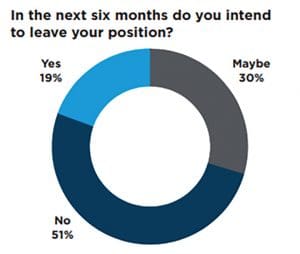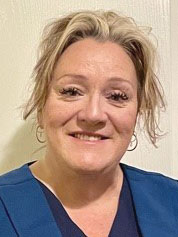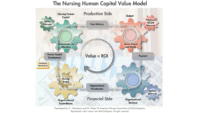Approaches to support nurse managers’ success.
The COVID-19 crisis has brought extraordinary challenges to all nurses and intensified the demands placed on nurse managers. Along with responsibilities for staffing and quality patient care, managers provide professional and emotional support to nurses under their supervision. When managers feel they should be accessible around the clock, work-life balance may seem almost impossible.


At a time when the nursing shortage has reached a national crisis level, according to the American Nurses Association (ANA), it’s essential for nurse leaders and healthcare organizations to offer approaches that make the role rewarding for managers and beneficial for their units. To support nurse managers, ANA provides focused workshops, a mentorship program that pairs nurse managers with more experienced nurse leaders, and resources for nurse staffing.
In addition, the American Nurses Credentialing Center Pathway to Excellence®program standards contribute to a healthy work environment. Nurse managers and leaders at organizations that have received Pathway to Excellence recognition described their experiences.
Responding to a public health crisis
In the 2021 Nursing Trends and Salary Survey conducted by American Nurse Journal, 78% of nurse manager respondents said their workload had increased in the past year.“


Our unit became the COVID-19 unit,” said Kimberley Kammann, MSN, RN, CNRN, CNML, a nurse manager in the medical oncology unit at Carson Tahoe Health in Carson City, Nevada, a Pathway to Excellence-designated organization. As a result, “We saw our nurses’ level of competency accelerate—they had to learn new things so quickly and things changed every day.”


In Indiana, Dena Andrew-Madden, MSN, RN, witnessed emergency nurses in her department becoming exhausted and fearful—not only for their patients but also for themselves and their families.
“Nurses are accustomed to change, but the day-to-day and sometimes hour-to-hour changes resulting from the pandemic, along with caring for sicker patients, was difficult and stressful,” said Andrew-Madden, practice supervisor in the emergency department at Indiana University Health Morgan.
To maintain a healthy work environment for staff, Andrew-Madden and her manager colleagues implemented new practices. In addition to checking in frequently with team members, managers “encourage the use of our tranquility rooms and use of Code Lavenders for respite breaks, support, and debriefing during challenging situations,” she said. They also offered flexible scheduling, allowing split shifts, time changes, and set schedules to meet the needs of the department and its team members.
Staffing in organizations across the country has been a major challenge, due in part to so many nurses leaving during the pandemic. Almost 71% of nurse manager respondents to the 2021 Nursing Trends and Salary Survey reported an increase in open positions during the past year.
Those losses, along with first-year turnover, have resulted in high vacancy rates. The positions are difficult to fill because many nurses have left to take contracted, short-term positions with higher pay incentives, Andrew-Madden said. “This makes staffing and retention a big challenge for nurse managers. As we struggle to fill positions, we still need to manage staffing on a daily basis due to surges in patient volume and acuity. We also need to prevent further burnout among team members and ourselves, all while ensuring that safety and patient care are not jeopardized,” she said.
The Pathway to Excellence effect
Andrew-Madden and Kammann work in Pathway to Excellence-designated organizations and said that the Pathway to Excellence standards help sustain nurse managers in their role.
Kammann, who is the Pathway to Excellence coordinator at Carson Tahoe, said that the standards “represent everything that our organization supports for nursing.” In particular, the organization’s commitment to employee wellness exemplifies the well-being standard. “We offer telehealth and an employee assistance program, along with wellness challenges and other initiatives that we encourage our staff to participate in,” she said.


Jonella Davis, MBA, BSN, RN, NEA-BC, vice president of operations at another Pathway to Excellence-designated organization, Tidelands Health in Murrells Inlet, SC, said theshared governance standard made an impact on Tidelands Health’s response to the COVID-19 crisis.
“We enlisted our unit-based shared governance as we started preparing for COVID-19, and nurses worked and came up with extremely creative solutions that helped us conserve PPE [personal protective equipment] and make sure patients and families got what they needed,” Davis said. “If we had not empowered our nurses to take the lead on these initiatives, we would have had much less success in patient care during the COVID-19 pandemic.”
Andrew-Madden credits the Pathway to Excellence standards with cultivating excellence during the pandemic. “By living the Pathway standards, we’ve fostered an environment where nurses feel empowered, and they make their voices heard,” she said. While managing the fast-evolving Centers for Disease Control and Prevention guidelines and recommendations and managing staffing and resources, “we also were listening to our frontline nurses and team members tell us what mattered most to them,” she said.
Mentors and leadership


Leadership visibility on the unit goes a long way too, so that nurse managers know who to go to for “at the elbow support,” said Andrew-Madden, an Indiana State Nurses Association member.
At Carson Tahoe Health, every shift starts with a shared meeting. The “Carson Tahoe MAP [Mission Alignment Process] Huddle,” as it’s called, begins with a quote and a moment to get grounded, and provides a chance for staff or leaders to recommend process improvements, which are communicated up to the executive leadership team. “It’s a two-way conversation,” said Kammann, which helps reinforce the organization’s strategic plan and the sense that everyone—from staff to leadership—is working toward the same goals.
Nurse leaders also can help by acknowledging their managers’ needs, said Kammann, a Nevada Nurses Association member. At Carson Tahoe Health, nurse managers have “leader protected time” from 9 to 11 AM Monday through Friday. During those hours, no meetings are scheduled, and nurse managers are not involved in any outside projects. They use that time to be present on their units, round on patients and staff, and offer staff assistance. “It’s an initiative that our chief nursing officer put in place, and it really helps,” Kammann said.
Work-life balance?
Work-life balance is an enduring challenge for all nurses, but it can be particularly difficult for nurse managers, whose responsibilities—especially staffing and scheduling—are hard to disconnect from.
“As a leader, you feel that you have to be available every second of every day,” said Andrew-Madden. “I’ve struggled with that in my role, but my mentor has helped me learn to set boundaries.”
Kammann agrees that top-down support empowers managers. “Having a great team of other leaders and peers around you makes all the difference,” she said. “When I’m going to be out, I know that my supervisor will be here and that I can count on the other managers to check in and make sure the unit is running smoothly.”


Moving forward
As nurses contend with COVID-19 patient surges, nurse managers must continue to provide extra support to staff. “We’re still reeling from burnout,” said Andrew-Madden. “It’s been really hard to get nurses re-engaged. They’re tired.”
Coming back from the devastation of the pandemic will take time. Andrew-Madden believes recovery will take strong backing from leaders, managers, and peers, along with “grace, time, and kindness.”
—Elizabeth Moore is a writer at the American Nurses Association.
Resources
ANA New Nurse Manager Basics Workshop (The next virtual workshop takes place in February 2022.)
ANA Mentorship Program (Enrollment for new cohort is Fall 2022)
ANCC Pathway to Excellence Program
COVID-19 Video Education Series—COVID-19 and your mental health
Pulse on the Nation’s Nurses Survey Series
________________________________________________________________________
Nurses continue to experience negative impacts of COVID-19
The American Nurses Foundation released findings in November from a new mental health and wellness survey of more than 9,500 nurses as part of the Pulse on the Nation’s Nurses Survey Series. As the pandemic approaches the 2-year mark, nurses report that they are still experiencing negative impacts of COVID-19 on their mental health and well-being, and the adverse side effects have increased significantly over the past year. (Read the report here.)


“The COVID-19 pandemic is not over yet and its impact will persist for a long time. Its challenges have left the nursing profession in a particularly vulnerable state, exacerbating nurse staffing shortages, and negatively impacting nurses’ quality of life,” said American Nurses Foundation Executive Director, Kate Judge. “Nurses are playing a pivotal role in efforts to end this pandemic, so we must ensure nurses are physically and psychologically safe and healthy to function optimally in caring first for themselves, their families, patients, and communities. A robust nursing workforce is essential to our nation’s health and therefore, nurses’ well-being and mental health must be a top priority. The data collected from this survey overwhelmingly demonstrate the need to provide consistent and comprehensive support for our nation’s nurses.” Read the findings here.

















